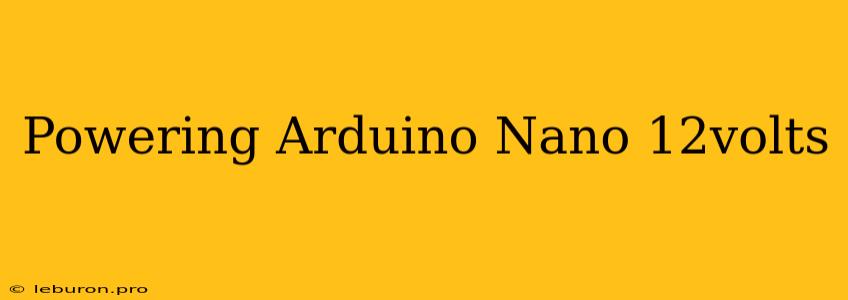The Arduino Nano, a popular microcontroller board known for its compact size and versatility, typically operates on a 5-volt power supply. However, there are scenarios where you might need to power the Arduino Nano with a higher voltage, such as using external sensors or actuators that require a 12-volt power source. This article will guide you through the process of powering an Arduino Nano with 12 volts, exploring the necessary components, circuits, and considerations to ensure safe and efficient operation.
Understanding the Need for a 12-Volt Power Supply
The Arduino Nano's internal circuitry is designed to operate on a 5-volt supply. Providing a higher voltage directly to the board can damage its components and potentially lead to malfunctions. Therefore, it's crucial to regulate the 12-volt input to a safe 5-volt level before feeding it to the Arduino Nano. This regulation is achieved using a voltage regulator.
Choosing a Suitable Voltage Regulator
The heart of powering an Arduino Nano with 12 volts is the voltage regulator. It's responsible for converting the 12-volt input into a stable 5-volt output for the Arduino Nano. There are several types of voltage regulators available, but the most common choice for this application is the linear voltage regulator, particularly the LM7805 chip.
Understanding the LM7805
The LM7805 is a fixed linear voltage regulator that provides a stable 5-volt output with a maximum current output of 1.5 amps. It's a popular choice for powering Arduino Nano with 12 volts due to its ease of use and availability. The LM7805 requires a minimum input voltage of 7 volts to operate correctly.
Alternative Regulators
While the LM7805 is a reliable choice, alternative regulators are available, such as the LM317, which is an adjustable linear voltage regulator allowing you to set the output voltage to the desired value. However, for powering an Arduino Nano with 12 volts, the LM7805 is generally preferred due to its simplicity and fixed 5-volt output.
Building the Powering Circuit
To power an Arduino Nano with 12 volts, you will need the following components:
- 12-volt power source: This can be a battery, power adapter, or any other suitable 12-volt supply.
- LM7805 voltage regulator: This component will regulate the 12-volt input to a safe 5-volt output.
- Input and output capacitors: These capacitors are essential for stabilizing the input and output voltage, preventing oscillations and ensuring smooth operation of the regulator. Typically, 0.1 µF capacitors are recommended for both the input and output.
- Breadboard or prototyping board: For building the circuit and testing the connection.
- Jumper wires: For connecting the components together.
Circuit Diagram
The circuit for powering an Arduino Nano with 12 volts is straightforward. Connect the following components as shown in the diagram:
- Connect the positive terminal of the 12-volt power source to the input terminal of the LM7805.
- Connect the negative terminal of the 12-volt power source to the ground pin of the LM7805.
- Connect the input capacitor between the input terminal of the LM7805 and ground.
- Connect the output terminal of the LM7805 to the 5V pin of the Arduino Nano.
- Connect the output capacitor between the output terminal of the LM7805 and ground.
- Connect the ground pin of the LM7805 to the ground pin of the Arduino Nano.
Building and Testing
Once you have assembled the circuit, connect the Arduino Nano to a computer via USB and upload a simple sketch to test the connection. If the sketch uploads and runs without any issues, you have successfully powered the Arduino Nano with 12 volts.
Powering Considerations
Powering an Arduino Nano with 12 volts requires careful considerations to ensure proper operation and prevent potential damage:
- Heat Dissipation: The LM7805 voltage regulator generates heat during operation, especially under high current loads. To prevent overheating, consider mounting the regulator on a heat sink or using a heat spreader.
- Current Rating: The LM7805 has a maximum current output of 1.5 amps. Ensure that the total current drawn by the Arduino Nano and any connected devices does not exceed this limit. If you need to power devices with higher current requirements, consider using a higher-current voltage regulator.
- Input Voltage: The input voltage to the LM7805 should be at least 7 volts to ensure proper operation. If the input voltage drops below this threshold, the regulator may not function correctly.
- Power Efficiency: Linear voltage regulators like the LM7805 are relatively inefficient, as they dissipate the excess voltage as heat. For applications requiring higher power efficiency, consider using a switching voltage regulator.
Alternatives to 12 Volt Powering
While powering an Arduino Nano with 12 volts offers the advantage of using readily available 12-volt power sources, there are alternative solutions:
- Using a 5-volt power adapter: The simplest approach is to use a dedicated 5-volt power adapter designed for the Arduino Nano. This eliminates the need for a voltage regulator and ensures a safe and efficient power supply.
- Using a USB power source: You can also power the Arduino Nano directly from a USB port. Many computer USB ports provide a 5-volt output suitable for the Arduino Nano.
- Using a battery pack: If portability is a priority, a 5-volt battery pack can be a convenient power source for the Arduino Nano.
Conclusion
Powering an Arduino Nano with 12 volts requires a simple yet crucial step of regulating the voltage using a voltage regulator. The LM7805 is a popular and reliable choice for this application, ensuring safe and efficient operation. However, remember to consider heat dissipation, current rating, input voltage, and power efficiency when implementing this method. By understanding these considerations and choosing the appropriate components, you can successfully power your Arduino Nano with 12 volts and expand its application possibilities.
